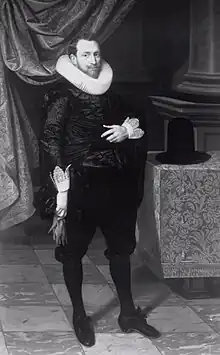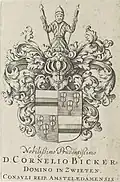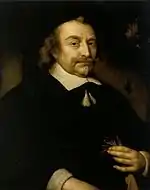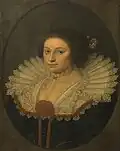Cornelis Bicker
Cornelis Bicker van Swieten (25 October 1592 – 15 September 1654), heer (lord) van Swieten, was an Amsterdam regent of the Dutch Republic during the Golden Age and a governor of the Dutch West India Company. He was also a sugar merchant, hoogheemraad of the Hoogheemraadschap van Rijnland and a counsellor of the States of Holland and West Friesland for Amsterdam at The Hague. He belonged to the Dutch States Party and was in opposition to the House of Orange.
Cornelis Bicker | |
|---|---|
 | |
| Cornelis Bicker painted by Cornelis van der Voort (1618) | |
| Burgomaster of Amsterdam | |
| Assumed office 1646, 1650, 1654 | |
| Bewindhebber of the Dutch East Indies Company | |
| Personal details | |
| Nationality | Dutch |
| Political party | States Faction |
| Spouse | Aleyd Boelens Loen |
| Relations | Andries Bicker (brother) Jan Bicker (brother) Cornelis de Graeff (cousin) Andries de Graeff (cousin and son-in-law) Cornelis Geelvinck (son-in-law) Lambert Reynst (son-in-law) Johan de Witt (nephew) |
| Children | Margaretha, Alida, Elisabeth, Maria, Gerard |
| Residence(s) | Singel 130 at Amsterdam, castle Swieten |
| Occupation | Burgomaster and Landlord |
| Profession | Merchant |
Cornelis Bicker, together with his brother Andries Bicker[1] and his cousin Cornelis de Graeff,[2] was one of the main initiators for a peace with Spain in the Eighty Years' War and for the participation of the Dutch provinces in the Peace of Münster.[3][4]
Life
Bicker Family
The Bicker family was one of the oldest patrician families of Amsterdam and belonged to the leading regent-oligarchy. The Bickers were the most powerful family in Amsterdam and decisively determined the fortunes of the city.[5][6] They were a major trading family involved in the pelt trade with Muscovy and supplying ships and silver to Spain. The Bicker-De Graeff family-faction became the strongest competitor in the years after the Dutch uprising. They controlled Amsterdam's city government and the province of Holland for half a century. Both families were powerful and influential between the earlier 17th century and the Rampjaar 1672 during the height of the Republic's power.[7] Through their work on the Amsterdam City Council and the Dutch East India Company, the Bickers gained enormous influence on politico-economic self-determination in the young Dutch Republic due to the city's position of economic power within the Republic.[8] Cornelis Bicker was the youngest son of Gerrit Bicker and Aleyd Andriesdr Boelens Loen.[9] Gerrit was a wealthy patrician, politician (burgomaster in 1603), international grain merchant and beer brewer.[10] and threw his work in the Amsterdam Vroedschap and as one of the founders of the East India Company, he was able to launch the careers of his sons, grandchildren and nephews. Cornelis' oldest brother Andries Bicker ruled the city administration for a long time and was mainly supported and carried by him and their other two brothers Jacob and Jan Bicker, his uncle Jacob Dircksz de Graeff and his cousin Cornelis de Graeff.[8] The Bicker brothers had a firm grip on world trade, trading on the East, the West, the North and the Mediterranean. Jans' uncle Laurens Bicker was one of the first to trade on Guinea and seized four Portuguese ships in 1604.
In 1617 Cornelis Bicker married Aertge Witsen (1599–1652)(1599–1652), daughter of merchant and burgomaster Gerrit Jacobsz Witsen. They had five children:[9]
- Margaretha Bicker van Swieten (1619–1697), ⚭ with Gerard van Hellemond and afterwards with Cornelis Geelvinck, burgomaster of Amsterdam
- Alida Bicker van Swieten (1620–1702), ⚭ with Lambert Reynst, burgomaster of Amsterdam
- Elisabeth Bicker van Swieten (1623–1656), ⚭ with her uncle and cousin Andries de Graeff, statesman, burgomaster of Amsterdam
- Maria Bicker van Swieten (1629–1653), ⚭ with Gerbrand Ornia
- Gerard Bicker (I) van Swieten (1632–1716), Rekenmeester van Holland en West-Friesland ⚭ I) with his grand cousin Alida van Papenbroek (1633–1656); II) with his cousin Cornelia Bicker (1638–1665); III) with Jkvr. Catherine van Sypesteyn (1629–1709)

Coat of arms
Description:
- Quartered, I and IV in gold a red crossbar Van den Anxter [maternal ancestors], II and III in silver three black tillers Helmer(s) [paternal ancestors] placed one above the other, A half-sighted helmet, wrinkled silver and red, tarpaulins red and gold, helmet sign an emerging beard man of natural color on a silver pedestal, dressed in old red clothes, gold knotted and decorated and with an old-fashioned red cap, gold decorated, holding with the right hand at the back and with the left hand at the front a golden torch.[11]
Genealogical and political Legacy
.jpg.webp)
Cornelis and Andries Bicker, together with their cousins Cornelis and Andries de Graeff, saw themselves as the political heirs of the old regent family Boelens, whose main lineage, which had remained catholic, had died out in the male line in 1647. They had received the very significant first names Andries and Cornelis from their Boelens ancestors. As in a real dynasty, members of the two families frequently intermarried in the 17th century in order to keep their political and commercial capital together. Its great historical ancestor was Andries Boelens (1455-1519), the city's most influential medieval mayor. Both families, Bicker and De Graeff, descend in the female line from Boelens. He was allowed to hold the highest office in Amsterdam fifteen times.[12]
Career
In 1617 Cornelis Bicker and his wife settled at Singel 130 in Amsterdam, in a building which his family only sold in 1767. In 1622 he became bewindhebber of the Dutch West India Company[11] and also held several directorships, such as of the Wisselbank.[9] In 1628 he became a schepen. In 1632 he bought the Swieten estate and manorhouse from Hugo Cuyk van Mierop - from these he later derived his noble title.[11][13][14] In 1634 he was appointed a captain in the schutterij (militia guard). He was burgomaster of Amsterdam in 1646, 1650 and 1654. In 1647 he became a deputy for East Friesland at the States General.[9]

Cornelis Bicker was member even of the Bickerse league, which included his brothers Andries, Jacob, Jan, Andries' son Gerard Bicker, and their distant cousins, the brothers Jacob Jacobsz Bicker (1612-1676; he was also the husband of Andries' daughter Alida Bicker) and Hendrick Jacobsz Bicker (1615-1651). They opposed the stadtholder Frederick Henry, Prince of Orange, who intended the centralize the five admiralties, which would cause the Admiralty of Amsterdam to lose influence.[15]
During the 1640s, the republican elite of the province of Holland, the brothers Cornelis, Andries,[1] Jacob and Jan Bicker,[16] Jacob de Witt and the brothers Andries[16] and Cornelis de Graeff advocated an end to the Eighty Years' War with the Kingdom of Spain and a reduction in land forces.[17] This ongoing state of war prevented the economic growth and social development of the Republic of the United Netherlands. Also, this state of war strengthened the atadtholder's power as commander-in-chief of the armed forces, something the Republicans did not want. This intensified the conflict between them and the stadtholder Frederick Henry of Orange and the Reformed Hollands.
During the 1640s, the influence of Andries Bicker, his family and the city grew even greater as the end of the Eighty Years' War drew nearer. Amsterdam's trade interests pointed in the direction of peace and she was able to push through under Bicker's leadership. The position of the Bicker family was then more powerful than any generation of mayors before or after them.[7] In 1648, due to the immense political pressure from the entire Bicker-De Graeff Clan[16] the United Netherlands entered into peace negotiations with Spain in order to end the Eighty Years' War with the Peace of Münster.[18]
_het_halthouden_van_de_oprukkende_Rijksmuseum_SK-C-1223.jpeg.webp)
After the peace treaties and the reduction of the land forces, the political opposition to the House of Orange and in particular to the new stadtholder William II, who wanted to make the city of Amsterdam docile in 1650 by means of a coup d'etat, deepened. In May 1650 he supported a proposal that suggested military cutbacks to encourage peace efforts. On 30 July 1650 the brothers Andries (old-burgomaster) and burgomaster Cornelis Bicker[1] activated the militia to defend against an attack on Amsterdam by the new stadholder William II after being warned of William's approach by a postman travelling from Hamburg to Amsterdam,[19] who passed on the news to Bicker's nephew (via his brother, the former burgomaster Andries) Gerard Bicker, then the bailiff or drost of Muiden. Gerard set off for Amsterdam immediately and after receiving the news Cornelis and Andries together with burgomaster Joan Huydecoper van Maarsseveen raised the bridges, shut the gates and deployed artillery. The attack failed but after the attack burgomaster Cornelis de Graeff passed on a message from William II that Cornelis and Andries[11] must resign from their posts on the town council.[9] However, they were restored to them on 22 November the same year afterwards William died shortly of smallpox.[11]
Cornelis Bicker's last appointment as burgomaster was in 1654, when he died.[9] He was buried in Amsterdam's Oude Kerk.
In art

Blick commissioned a large-format portrait of himself and his family from Cornelis van der Voort in 1618. Cornelis Bicker also appears as a captain in a 1638 militia group portrait by Joachim von Sandrart, commissioned by the Kloveniersdoelen to mark the visit of Maria de Medici and now in the Rijksmuseum in Amsterdam.[20][21] Another painting of Blick dates to 1654 and is attributed to Govert Flinck - this work was praised by Vondel.[22] His wife was also painted by David Bailly.[23]
References
- Andries and Cornelis Bicker at Letterkundig woordenboek voor Noord en Zuid
- Oliver Krause: Die Variabilität frühneuzeitlicher Staatlichkeit. Die niederländische „Staats“-Formierung der Statthaltosen Epoche (1650–1672) als interkontinentales Regiment (Franz Steiner Verlag, Stuttgart 2018)
- Amsterdam: a brief life of the city. By Geert Mak, Harvill Press (1999), p 123
- Buitenplaatsen in de Gouden Eeuw: De rijkdom van het buitenleven in de Republik. By Y. Kuiper, Ben Olde Meierink, Elyze Storms-Smeets, p 71 (2015)
- Seefahrer in schwedischen Diensten: Seeschifffahrt und Technologietransfer im 17. Jahrhundert, by Hielke van Nieuwenhuize, p 232 (2022)
- Geschichte der Niederlande: Von der Seemacht zum Trendland, by Christoph Driessen (2022)
- (in Dutch) Biography of Andries Bicker on DBNL
- Familial State: Ruling Families and Merchant Capitalism in Early Modern Europe, by Julia Adams, p 99 (2005)
- Johan Engelbert Elias, De Vroedschap van Amsterdam, 1578-1795, Deel 1, p 175
- Abraham Jacob van der Aa, Biographisch Woordenboek der Nederlanden (BWN), (1878), volume 1-2, p 517
- Biography Cornelis Bicker Biography at Nieuw Nederlands Biografisch Woordenboek
- DBNL, Amsterdamse burgemeesters zonder stamboom. De dichter Vondel en de schilder Colijns vervalsen geschiedenis, by S.A.C. Dudok van Heel, p 147 (1990)
- (in Dutch) Het kasteel Zwieten te Zoeterwoude
- (in Dutch) Het Kasteel Swieten
- Burke, P. (1974) Venice and Amsterdam. London: Temple Smith, p. 59?
- Amsterdam: a brief life of the city. By Geert Mak, Harvill Press (1999), p 123
- Oliver Krause: Die Variabilität frühneuzeitlicher Staatlichkeit. Die niederländische „Staats“-Formierung der Statthaltosen Epoche (1650–1672) als interkontinentales Regiment (Franz Steiner Verlag, Stuttgart 2018)
- Buitenplaatsen in de Gouden Eeuw: De rijkdom van het buitenleven in de Republik. Herausgegeben von Y. Kuiper, Ben Olde Meierink, Elyze Storms-Smeets, S. 71 (2015)
- Abraham Jacob van der Aa, Biographisch Woordenboek der Nederlanden (BWN), (1878), volume 1-2, p 519
- (in Dutch) Rijksmuseum Amsterdam
- Captain Bicker's company ready to receive Maria de Medici in September 1638, (ca 1638-40), by Joachim von Sandrart (Rijksmuseum Amsterdam)
- (in Dutch)Poem by Vondel
- (Rijksmuseum)
Bibliography
- Jonathan I. Israel: The Dutch Republic: Its Rise, Greatness, and Fall: 1477-1806. Clarendon Press, Oxford 1995, ISBN 978-0-19-820734-4
- (in Dutch) Cornelis Bicker - Biography on DBNL
- (in Dutch) Kernkamp, G.W. (1977) Prins Willem II 1626-1650
- (in Dutch) P. Burke: Venetië en Amsterdam. Een onderzoek naar de elites in de zestiende eeuw. 1974
- (in Dutch) J.E. Elias, De Vroedschap van Amsterdam 1578-1795, deel 1 (Haarlem 1903), p. 175
- (in Dutch) Zandvliet, Kees De 250 rijksten van de Gouden Eeuw - Kapitaal, macht, familie en levensstijl (2006 Amsterdam; Nieuw Amsterdam Uitgevers)